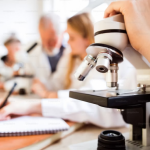Quantum News Briefs August 14: Google Chrome to shield encryption keys from future quantum computers; Environmental monitoring with quantum sensors; Rensselaer Polytechnic Institute plans to deploy first IBM Quantum System One on a university campus + MORE

Quantum News Briefs August 14:
Google Chrome to shield encryption keys from future quantum computers
 Google has started deploying a hybrid key encapsulation mechanism (KEM) to protect the sharing of symmetric encryption secrets during the establishment of secure TLS network connections. Quantum News Briefs summarizes Thomas Claburn’s August 12 article in The A Register.
Google has started deploying a hybrid key encapsulation mechanism (KEM) to protect the sharing of symmetric encryption secrets during the establishment of secure TLS network connections. Quantum News Briefs summarizes Thomas Claburn’s August 12 article in The A Register.
Devon O’Brien, technical program manager for Chrome security, explained that starting in Chrome 116 – due August 15 – Google’s browser will include support for X25519Kyber768, an alphanumeric salad that desperately needs a catchy name.
The unwieldy term is a concatenation of X25519, an elliptic curve algorithm that’s currently used in the key agreement process for establishing a secure TLS connection, and Kyber-768, a quantum-resistant KEM that last year won NIST’s blessing for post-quantum cryptography.
Google is deploying a hybrid version of these two algorithms in Chrome so the web goliath, users of its technology, and other network providers like Cloudflare, can test quantum-resistant algorithms while maintaining current protections.
Google is deploying a hybrid version of these two algorithms in Chrome so the web goliath, users of its technology, and other network providers like Cloudflare, can test quantum-resistant algorithms while maintaining current protections. Wome day, many very bright people believe, quantum computers will be able to break at least some legacy encryption schemes. That belief is what motivated US technical agency NIST in 2016 to call for future-proof encryption algorithms.
“. . .why is it important to start protecting traffic today?” said O’Brien. “The answer is that certain uses of cryptography are vulnerable to a type of attack called Harvest Now, Decrypt Later, in which data is collected and stored today and later decrypted once cryptanalysis improves.”
O’Brien says that while symmetric encryption algorithms used to defend data traveling on networks are considered safe from quantum cryptanalysis, the way the keys get negotiated is not. By adding support for a hybrid KEM, Chrome should provide a stronger defense against future quantum attacks. Click here to read The A Register article in-entirety.
Environmental monitoring with quantum sensors
 The exceptional performance of quantum sensors lies in their ability to manipulate and measure quantum states. They make use of phenomena such as atomic transitions, photon detection, or spin manipulation to capture and interpret signals emanating from the surrounding environment. This capability empowers quantum sensors to push the boundaries of measurement precision, turning them into indispensable tools across a wide spectrum of scientific and engineering applications. Quantum News Briefs summarizes August 7 article by
The exceptional performance of quantum sensors lies in their ability to manipulate and measure quantum states. They make use of phenomena such as atomic transitions, photon detection, or spin manipulation to capture and interpret signals emanating from the surrounding environment. This capability empowers quantum sensors to push the boundaries of measurement precision, turning them into indispensable tools across a wide spectrum of scientific and engineering applications. Quantum News Briefs summarizes August 7 article by
Using Quantum Sensors for Measuring Earth’s Gravitational Field
Due to the pressing climate change issue, ice caps are melting, which leads to higher sea levels. Because of this, the Earth’s gravitational field experiences slight changes. A pioneering endeavor has begun as both engineers and scientists join hands to accurately assess this change by using Photonic Integrated Circuits (PIC)-based quantum sensors. These sensors will be deployed from outer space and detect very small gravitational changes, leading to a higher degree of accuracy in predicting the most critical climate factors, such as ocean heat storage and risks of flooding.
Monitoring Marine Gravimetry Using Quantum Technologies
Gravity measurements offer valuable insights into the topography, underground mass distribution, tectonic structure, ice melting, water storage variation, and more, shaping our understanding of the planet’s dynamics and aiding navigation algorithms. Quantum technologies enhance precision in marine gravimetry, revolutionizing our ability to map and monitor gravity-related phenomena.
Unveiling Soil’s Hidden Depths with Quantum Sensors
Quantum sensors have opened up new avenues for analyzing soil composition with remarkable accuracy. These sensors can detect and quantify the presence of various elements and compounds within the soil. This capability allows scientists to gain valuable insights into the soil’s chemical composition, identifying nutrient deficiencies, heavy metal contamination, and other factors that impact plant growth and environmental health.
Click here to read the AzoQuantum article in-entirety.
Rensselaer Polytechnic Institute plans to deploy first IBM Quantum System One on a university campus

Rensselaer Polytechnic Institute will become the first university in the world to house an IBM Quantum System One. Quantum News Briefs summarizes the announcement.
The IBM quantum computer, intended to be operational by January of 2024, will serve as the foundation of a new IBM Quantum Computational Center in partnership with Rensselaer Polytechnic Institute (RPI). By partnering, RPI’s vision is to greatly enhance the educational experiences and research capabilities of students and researchers at RPI and other institutions, propel the Capital Region into a top location for talent, and accelerate New York’s growth as a technology epicenter.
RPI’s advance into research of applications for quantum computing will represent a more than $150 million investment once fully realized, aided by philanthropic support from Curtis R. Priem ’82, vice chair of RPI’s Board of Trustees. The new quantum computer will be part of RPI’s new Curtis Priem Quantum Constellation, a faculty endowed center for collaborative research, which will prioritize the hiring of additional faculty leaders who will leverage the quantum computing system.
“Today’s quantum computers are novel, scientific tools that can be used to model problems that are extremely difficult, and perhaps impossible, for classical systems, signaling that we are now entering a new phase of utility for quantum computing,” said Darío Gil, Senior Vice President and Director of IBM Research. “We expect this collaboration to continue to have tremendous impact for the area’s growth as a corridor of innovation, from New York City to the Capital Region. We are thrilled to collaborate with RPI as we continue to nurture the global quantum ecosystem of tomorrow.”
RPI has a storied history in advanced technology and is already home to one of the most powerful supercomputers in the world, the Artificial Intelligence Multiprocessing Optimized System (AiMOS). AiMOS, at a top peak processing speed of 11.03 petaFLOPS, is currently the most powerful private university-based supercomputer in the United States. The IBM POWER9 CPU and NVIDIA GPU-equipped supercomputer enables users to explore new AI applications. Click here to read the complete announcement.
Is quantum computing the future of DNA analysis?
 DNA sequencing technology, i.e., determining the order of nucleotide bases in a DNA molecule, is central to personalized medicine and disease diagnostics, yet even the fastest technologies require hours, or days, to read a complete sequence. Now, a multi-institutional research team led by The Institute of Scientific and Industrial Research (SANKEN) at Osaka University, has developed a technique using quantum technology that could lead to a new paradigm for genomic analysis. Quantum News Briefs summarizes the August 3 article from Osaka University.
DNA sequencing technology, i.e., determining the order of nucleotide bases in a DNA molecule, is central to personalized medicine and disease diagnostics, yet even the fastest technologies require hours, or days, to read a complete sequence. Now, a multi-institutional research team led by The Institute of Scientific and Industrial Research (SANKEN) at Osaka University, has developed a technique using quantum technology that could lead to a new paradigm for genomic analysis. Quantum News Briefs summarizes the August 3 article from Osaka University.
In a study recently published in the Journal of Physical Chemistry B, the researchers aimed to use a quantum computer to distinguish adenosine from the other three nucleotide molecules. Using quantum encoding to identify single nucleotide molecules is a necessary first step toward the ultimate goal of DNA sequencing, and it’s this problem that the researchers sought to address.
“Using a quantum circuit, we show how to detect a nucleotide from only the measurement data of a single molecule,” explains Masateru Taniguchi, lead author of the study. “This is the first time a quantum computer has been connected to measurement data for a single molecule, and demonstrates the feasibility of using quantum computers in genome analysis.”
Tomofumi Tada, senior author of the study. “In the present setup, discrimination of adenosine monophosphate from the other three nucleotides is not necessarily straightforward, but DNA sequencing could be possible by designing quantum gates for these other nucleotides as well.”
This work has broad and exciting potential applications: advances in drug discovery, cancer diagnosis, and infectious disease research are a few examples of what is expected with the advent of ultra-fast genome analysis. Click here to read original article in-entirety.
Sandra K. Helsel, Ph.D. has been researching and reporting on frontier technologies since 1990. She has her Ph.D. from the University of Arizona.



















